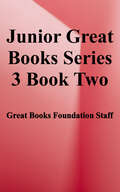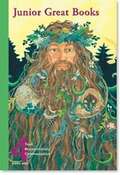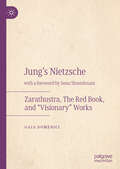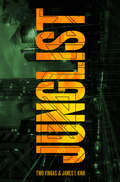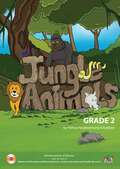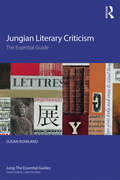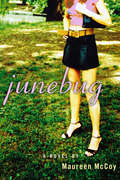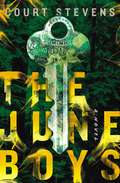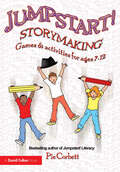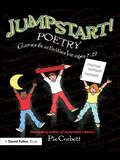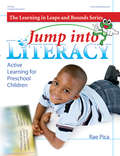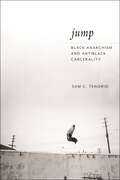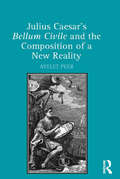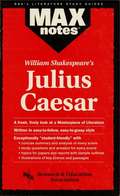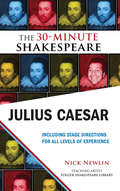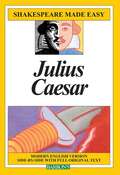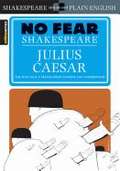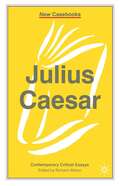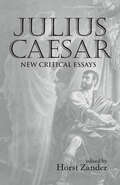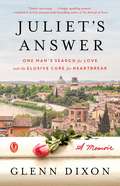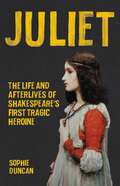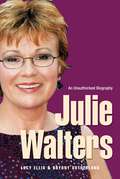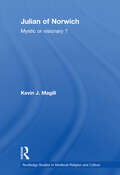- Table View
- List View
Junior Great Books (Series 3 #2)
by Great Books Foundation StaffJunior Great Books Series 3 introduces students to outstanding, interpretive literature from around the world. Book Two of Series 3 features nine stories by award-winning authors. These stories are organized around three themes: gratitude, courage, and cleverness.
Junior Great Books: Book One
by Great Books Foundation StaffSeries 4, Book One Student Edition (2014)
Jung's Nietzsche: Zarathustra, The Red Book, and “Visionary” Works
by Gaia DomeniciThis book explores C.G. Jung's complex relationship with Friedrich Nietzsche through the lens of the so-called 'visionary' literary tradition. The book connects Jung's experience of the posthumously published Liber Novus (The Red Book) with his own (mis)understanding of Nietzsche's Zarathustra, and formulates the hypothesis of Jung considering Zarathustra as Nietzsche's Liber Novus –– both works being regarded by Jung as 'visionary' experiences. After exploring some 'visionary' authors often compared by Jung to Nietzsche (Goethe, Hölderlin, Spitteler, F. T. Vischer), the book focuses upon Nietzsche and Jung exclusively. It analyses stylistic similarities, as well as explicit references to Nietzsche and Zarathustra in Liber Novus, drawing on Jung's annotations in his own copy of Zarathustra. The book then uses Liber Novus as a prism to contextualize and understand Jung's five-year seminar on Zarathustra: all the nuances of Jung's interpretation of Zarathustra can be fully explained, only when compared with Liber Novus and its symbology. One of the main topics of the book concerns the figure of 'Christ' and Nietzsche's and Jung's understandings of the 'death of God.'
Junglist
by Two Fingas James KirkBack in print after more than twenty years, this cult classic of underground British fiction tells the story of young Black men coming of age among the raves and jungle music of London in the 1990s.Back in print after two decades, Junglist tells the compelling, comic, stream-of-consciousness story of four young Black men coming of age among the raves and Jungle music scene in London during the 1990s.Layered with poetic verse, prose and humour, this cult classic of underground British fiction documents the rollercoaster ride of a weekend spent raving during Jungle&’s cultural takeover in the summer of 1994. Jungle, with its booming basslines and Jamaican patois, burst from the pirate radio stations and mixtapes into cavernous clubs, pulling a generation of Black British ravers with it.Originally written as a way to document street culture as it became a feature of London, charting a time when working-class kids, both Black and white, merged to dance as "one family", Junglist is both a testament to Black British sound system culture and a rawthentic account of inner-city life.
Jungle Animals class 2 - MIE
by Hélina Hookoomsing-Dookhee"Jungle Animals" is a vibrant and engaging big book designed for Grade 2 students, aiming to enhance English literacy skills. The book takes young readers on a vivid exploration of the lively jungle, introducing a variety of captivating animals through descriptive verses and colorful illustrations. From the gentle elephant using its trunk to the playful monkeys swinging in the trees, each page unfolds with different creatures showcasing their distinct characteristics. As the narrative progresses, children encounter diverse jungle inhabitants like the graceful giraffe, slumbering parrots, and the roaring jungle cats – lions, tigers, and leopards. Through interactive sessions, including pre-reading discussions, story readings, and post-reading activities, the book encourages active participation, vocabulary enrichment, and imaginative role-playing, fostering an enjoyable and educational experience for Grade 2 pupils while linking the narrative to their English curriculum.
Jungian Literary Criticism: The Essential Guide (Jung: The Essential Guides)
by Susan RowlandIn Jungian Literary Criticism: the essential guide, Susan Rowland demonstrates how ideas such as archetypes, the anima and animus, the unconscious and synchronicity can be applied to the analysis of literature. Jung’s emphasis on creativity was central to his own work, and here Rowland illustrates how his concepts can be applied to novels, poetry, myth and epic, allowing a reader to see their personal, psychological and historical contribution. This multidisciplinary and transdisciplinary approach challenges the notion that Jungian ideas cannot be applied to literary studies, exploring Jungian themes in canonical texts by authors including Shakespeare, Jane Austen and W. B. Yeats as well as works by twenty-first century writers, such as in digital literary art. Rowland argues that Jung’s works encapsulate realities beyond narrow definitions of what a single academic discipline ought to do, and through using case studies alongside Jung’s work she demonstrates how both disciplines find a home in one another. Interweaving Jungian analysis with literature, Jungian Literary Criticism explores concepts from the shadow to contemporary issues of ecocriticism and climate change in relation to literary works, and emphasises the importance of a reciprocal relationship. Each chapter concludes with key definitions, themes and further reading, and the book encourages the reader to examine how worldviews change when disciplines combine. The accessible approach of Jungian Literary Criticism: the essential guide will appeal to academics and students of literary studies, Jungian and post-Jungian studies, literary theory, environmental humanities and ecocentrism. It will also be of interest to Jungian analysts and therapists in training and in practice.
Jung as a Writer
by Susan RowlandJung as a Writer traces a relationship between Jung and literature by analysing his texts using the methodology of literary theory. This investigation serves to illuminate the literary nature of Jung’s writing in order to shed new light on his psychology and its relationship with literature as a cultural practice. Jung employed literary devices throughout his writing, including direct and indirect argument, anecdote, fantasy, myth, epic, textual analysis and metaphor. Susan Rowland examines Jung’s use of literary techniques in several of his works, including Anima and Animus, On the Nature of the Psyche, Psychology and Alchemy and Synchronicity and describes Jung’s need for literature in order to capture in writing his ideas about the unconscious. Jung as a Writer succeeds in demonstrating Jung’s contribution to literary and cultural theory in autobiography, gender studies, postmodernism, feminism, deconstruction and hermeneutics and concludes by giving a new culturally-orientated Jungian criticism. The application of literary theory to Jung’s works provides a new perspective on Jungian Psychology that will be of interest to anyone involved in the study of Jung, Psychoanalysis, literary theory and cultural studies.
Junebug
by Maureen Mccoy"I was raised zero-parent," says hormone-addled 17-year-old Junebug Host, "what the newspapers call it when your mother is in prison and the father was just a sperm."Junebug has been visiting her mother in Ellisville Reformatory for Women ever since she was five years-old, when beauty queen Theresa Host calmly stepped out of their trailer with an axe and inexplicably bludgeoned a neighbor to death. But during the summer of Junebug's high school graduation--and the summer of her first wildly passionate affair--with a snake-smooth greaser 20 years her senior--Theresa reels in her oversexed daughter, and shatters her world, by suddenly announcing the motive she had kept to herself since the day of the murder: an act of vengeance for a crime in which Junebug was intimately involved. "I did it for you," she tells Junebug, who is thrown into a ferment of memory and guilt.Set in the outsized landscape of far-western Nebraska, a nebulous region little known in contemporary fiction, and peopled by characters whose extreme individuality is exceeded only by their eccentricity--born again Fundamentalist snake charmers, housewives making ends meet with phone sex 900-number businesses, a 300-pound New Age priestess and the traveling meat salesman who worships her, as well as the all-female inmate population of the Ellisville Reformatory, Junebug is a novel with the intensity of the mother/daughter bond itself, with all its wildness, tragedy and depth.Maureen McCoy is the author of three previous novels, Diving Blood, Summertime, and Walking After Midnight (Poseiden/Simon & Schuster). She received her MFA from the Writers Workshop, University of Iowa, and is a Professor of English at Cornell. Among her many awards are the James Michener Award, the Wurlitzer Foundation Award, and the Albert Schweitzer Fellowship in the Humanities, chosen by Toni Morrison.
The June Boys
by Court StevensThe Gemini Thief could be anyone.Your father, your mother, your best friend&’s crazy uncle.Some country music star&’s deranged sister. Anyone.Someone is stealing Tennessee&’s boys.REPORT SUSPICIOUS BEHAVIOR.The Gemini Thief is a serial kidnapper, who takes three boys and holds them captive from June 1st to June 30th of the following year. The June Boys endure thirteen months of being stolen, hidden, observed, and fed before they are released, unharmed, by their masked captor. The Thief is a pro, having eluded authorities for nearly a decade and taken at least twelve boys.Now Thea Delacroix has reason to believe the Gemini Thief has taken a thirteenth victim: her cousin, Aulus McClaghen.But the game changes when one of the kidnapped boys turns up dead. Together with her boyfriend Nick and her best friends, Thea is determined to find the Gemini Thief and the remaining boys before it&’s too late. Only she&’s beginning to wonder something sinister, something repulsive, something unbelievable, and yet, not impossible:What if her father is the Gemini Thief?Praise for The June Boys:&“Not only a terrifying story of the missing, but a heartbreaking, hopeful journey through the darkness.&” —MEGAN MIRANDA, New York Times bestselling author of The Last House Guest&“Stunning twists and turns. Hang on tight.&” —RUTA SEPETYS, international bestselling author&“A gripping suspense that hooked me from the first sentence.&” —COLLEEN COBLE, USA TODAY bestselling author of One Little Lie and the Lavender Tides series&“I was hooked and couldn&’t stop reading.&” —CATHERINE BOCK, book buyer for Parnassus BooksFull-length, stand-alone Young Adult suspense novelIncludes Discussion Questions for Book Clubs
Jumpstart! Storymaking: Games and Activities for Ages 7-12 (Jumpstart)
by Pie CorbettJumpstart! Storymaking is a collection of games and activities to develop the creative process of ‘storymaking’. It focuses upon 'storytelling for writing' as well as creating a whole school culture of storytelling, reading and writing. Storymaking is the process of retelling, innovating and creating new stories. Like the best-selling Jumpstart! Literacy, this book contains imaginative ‘quick-fire' ideas that could be used as creative warm-ups and starters or developed into lessons. There are over 100 provocative and thought-provoking games and activities, intended to ‘jumpstart’ storytelling, reading and writing in any Key Stage 1, 2 or 3 classroom. Practical, easy-to-do and vastly entertaining, the ‘jumpstarts’ will appeal to busy teachers.
Jumpstart! Poetry: Games and Activities for Ages 7-12 (Jumpstart)
by Pie CorbettA good poetry idea should help the children feel excited about writing and enable them to think of what to write - developing their imagination, creativity and writing skills. Jumpstart! Poetry is about involving children as creative writers through writing poems. The book contains a bank of ideas that can be drawn upon when teaching poetry but also at other times to provide a source for creative writing that children relish. There are more than 100 quick warm-ups to fire the brain into a creative mood and to ‘jumpstart’ reading, writing and performing poetry in any key stage 1 or 2 classroom. Practical, easy-to-do and vastly entertaining, this new ‘jumpstarts’ will appeal to busy teachers in any primary classroom.
Jump Into Literacy: Active Learning for Preschool Children
by Rae PicaJump into Literacy combines children's love of active games with over 100 lively literacy activities. Written by a well-known children's movement specialist, these joyful games will engage the whole child in moving and playing as a way to develop the literacy skills needed for reading and writing. Each activity is complete with a literacy objective, a materials list, instructions, and extension activities. Most of the activities include suggestions for related music and children's books. From "The Alphabet in Action" to "Floorwriting" and "Follow That Letter," the activities in Jump into Literacy bring active learning to the classroom!
Jump: Black Anarchism and Antiblack Carcerality
by Sam C. TenorioAsks how we can better understand a politics of refusalWriting a new story of Black politics, Jump emerges from the practice of enslaved Africans jumping overboard off their slavers’ ships. Reading against the narrative that depoliticizes and denigrates the leaps of the enslaved as merely suicidal symptoms of chattel slavery and the Middle Passage, Sam C. Tenorio demonstrates how bringing these jumps to bear on the foundations of Black politics allows us to rethink a politics of refusal.In a period of increasing political mobilization against police brutality and mass incarceration, Jump attends to the layers of confinement that constitute the racial and gendered hierarchies of the antiblack world. Centering radical acts too often relegated to the periphery of Black politics, Tenorio proposes a Black anarchist politics of refusal that helps us to think dissent anew.Tracing iterations of the jump through the carceral wake of the slave ship, Tenorio explores the voyages of the Black Star Line in defiance of the bordered authority of the nation state, the Watts Rebellion of 1965 against the property relation of ghettoization, and Assata Shakur’s abscondence from prison to Cuba. Ultimately, Tenorio argues that considering the jump as a progenitor of Black politics deepens and widens our conceptualization of the Black radical tradition and introduces a paradigm-shifting attention to Black anarchism.
Julius Caesar's Bellum Civile and the Composition of a New Reality
by Ayelet PeerIn his Commentarii de Bello Civili Julius Caesar sought to re-invent his image and appear before his present and future readers in a way which he could control and at times manipulate. Offering a new interpretation of the Bellum Civile this book reveals the intricate literary world that Caesar creates using sophisticated techniques such as a studied choice of vocabulary, rearrangement of events, use of indirect speech, and more. Each of the three books of the work is examined independently to set out the gradual transformation of Caesar's literary persona, in step with his ascent in the 'real' world. By analysing the work from Caesar's viewpoint the author argues that by adroit presentation and manipulation of historical circumstances Caesar creates in his narrative a different reality, one in which his conduct is justified. The question of the res publica is also a key point of the volume, as it is in the Bellum Civile, and the author argues that Caesar purposely does not present himself as a Republican, contrary to commonly held views. Employing detailed philological analyses of Caesar's three books on the Civil War, this work significantly advances our understanding of Caesar as author and politician.
Julius Caesar (MAXNotes Literature Guides)
by Joseph ScaliaREA's MAXnotes for William Shakespeare's Julius Caesar The MAXnotes offers a comprehensive summary and analysis of Julius Caesar and a biography of William Shakespeare. Places the events of the play in historical context and discusses each act in detail. Includes study questions and answers along with topics for papers and sample outlines.
Julius Caesar: The 30-Minute Shakespeare
by Nick NewlinJulius Caesar: The 30-Minute Shakespeare presents eight spellbinding scenes from this timeless masterpiece. The action begins as the soothsayer warns Caesar of the Ides of March and continues as Brutus conspires against Caesar. Other key scenes include Caesar's riveting assassination and Antony's stirring funeral oration. This adaptation closes with Cinna the Poet's death at the hands of the mob, the quarrel between Brutus and Cassius, and Brutus' suicide. The edition includes a preface by Nick Newlin containing helpful advice on presenting Shakespeare in a high school setting with novice actors, as well as an appendix with play-specific suggestions and recommendations for further resources.
Julius Caesar: Modern English Version Side-by-side With Full Original Text (Shakespeare Made Easy)
by William Shakespeare Alan DurbandHere are the books that help teach Shakespeare plays without the teacher constantly needing to explain and define Elizabethan terms, slang, and other ways of expression that are different from our own. Each play is presented with Shakespeare's original lines on each left-hand page, and a modern, easy-to-understand "translation" on the facing right-hand page. All dramas are complete, with every original Shakespearian line, and a full-length modern rendition of the text. These invaluable teaching-study guides also include: Helpful background information that puts each play in its historical perspective. Discussion questions that teachers can use to spark student class participation, and which students can use as springboards for their own themes and term papers. Fact quizzes, sample examinations, and other features that improve student comprehension of what each play is about.
Julius Caesar (No Fear Shakespeare)
by William Shakespeare SparkNotes StaffNo Fear Shakespeare gives you the complete text of Julius Caesar on the left-hand page, side-by-side with an easy-to-understand translation on the right. <p><p> Each No Fear Shakespeare contains <p> The complete text of the original play <p> A line-by-line translation that puts Shakespeare into everyday language <p> A complete list of characters with descriptions <p> Plenty of helpful commentary
Julius Caesar
by Richard WilsonJulius Caesar: A New Casebook provides students and academics with a selection of important essays by leading contemporary critics on Shakespeare's first "Globe" play. New historicist, feminist, psychoanalytic and Marxist readings of the tragedy have been chosen to highlight the urgency with which this drama of prophecy, interpretation and political crisis speaks to twenty-first century concerns about democracy, the media and mass communication.
Julius Caesar: New Critical Essays (Shakespeare Criticism #Vol. 29)
by Horst ZanderThis book explores traditional approaches to the play, which includes an examination of the play in light of current history, in the context of Renaissance England, and in relation to Shakespeare's other Roman plays as well as structural examination of plot, language, character, and source material. Julius Caesar: Critical Essays also examines the current debates concerning the play in Marxist, psychoanalytic, deconstructive, queer, and gender contexts.
Juliet's Answer: One Man's Search for Love and the Elusive Cure for Heartbreak
by Glenn DixonEat, Pray, Love meets The Rosie Project in this fresh, heartwarming memoir by a man who travels to Verona and volunteers to answer letters addressed to Shakespeare’s Juliet, all in an attempt to heal his own heartbreak.When Glenn Dixon is spurned by love, he packs his bags for Verona, Italy. Once there, he volunteers to answer the thousands of letters that arrive addressed to Juliet—letters sent from lovelorn people all over the world to Juliet’s hometown; people who long to understand the mysteries of the human heart.Glenn’s journey takes him deep into the charming community of Verona, where he becomes involved in unraveling the truth behind Romeo and Juliet. Did these star-crossed lovers actually exist? Why have they remained at the forefront of hearts and minds for centuries? And what can they teach us about love?When Glenn returns home to Canada and resumes his duties as an English teacher, he undertakes a lively reading of Romeo and Juliet with his students, engaging them in passions past and present. But in an intriguing reversal of fate and fortune, his students—along with an old friend—instruct the teacher on the true meaning of love, loss, and moving on.An enthralling tale of modern-day love steeped in the romantic traditions of eras past, this is a memoir that will warm your heart.
Juliet: The Life and Afterlives of Shakespeare's First Tragic Heroine
by Sophie DuncanThe enduring cultural legacy of Shakespeare&’s Juliet Capulet — a history "as vital and provocative as the character herself" (Literary Review).Romeo and Juliet may be the greatest love story ever told, but who is Juliet? Demure ingénue? Or dangerous Mediterranean madwoman? From tearstained copies of the First Folio to Civil War-era fanfiction, Shakespeare&’s star-crossed heroine has long captured our collective imagination. Juliet is her story, traced across continents through four centuries of history, theatre, and film. As Oxford Shakespeare scholar Sophie Duncan reveals, Juliet&’s legacy stretches beyond her literary lifespan into a cultural afterlife ranging from enslaved African girls in the British Caribbean to the real-life Juliets of sectarian violence in Bosnia and Belfast. She argues that our dangerous obsession with the beautiful dead teenager and Juliet&’s meteoric rise as a defiant sexual icon have come to define the Western ideal of romance. Wry and inventive, Juliet is a tribute to fiction&’s most famous teenage girl who died young, but who lives forever.
Julie Walters: Seriously Funny - An Unauthorised Biography
by Bryony Sutherland Lucy EllisFrom her BAFTA-winning television work, such as My Beautiful Son, to her big screen debut alongside Michael Caine in Educating Rita, her starring in Billy Elliot (both of which earned her Oscar nominations) and her portrayal of Mrs Weasley in the Harry Potter films, Julie Walters has worked with some of the greatest and most diverse actors and directors in the world today. In December 2005, at the British Comedy Awards, Walters - alongside longtime friend and television comedy partner Victoria Wood - picked up the Outstanding Contribution to Comedy Award.Raised in a strict Catholic family in working class Birmingham, Julie Walters abandoned a nursing course to study drama at Manchester Polytechnic and went on to join the Liverpool Everyman Theatre where she cut her teeth as an actress. Over the next decade, she experienced three marriage proposals, two long-term romances and a period of heavy drinking. At the end of 1984 she met sociology student Grant Roffey and had a daughter Maisie, who was traically diagnosed with luekaemia and had to undergo years of painful chemotherapy.the authors have interviewed friends, teachers and colleagues to skilfully compile the first-ever biography of one of Britain's finest and best-loved actresses.
Julian of Norwich: Mystic or Visionary? (Routledge Studies in Medieval Religion and Culture)
by Kevin MagillJulian of Norwich was a fourteenth-century woman who at the age of thirty had a series of vivid visions centred around the crucified Christ. Twenty years later, while living as an anchoress in a church, she is believed to have set out these visions in a text called the Showing of Love. Going against the current trend to place Julian in the category of mystic - a classification which defines her visions as deeply private, psychological events - this book sets Julian’s thinking in the context of a visionary project used to instruct the Christian community. Drawing on recent developments in philosophy that debate the objectivity and rationality of vision and perception, Kevin J. Magill gives full attention to the depth and richness of the visual language and modes of perception in the Showing of Love. In particular, the book focuses on the ways in which Julian presented her vision to the Christian society around her, demonstrating the educative potential of interaction between the ‘isolated’ anchoress and the wider community. Challenging Julian’s identification as a mystic and solitary female writer, this book argues that Julian engaged in a variety of educative methods – oral, visual, conversational, mnemonic, alliterative – that extend the usefulness of her text.

